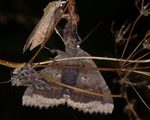Whilst custom-built moth-traps offer the easiest method of recording moths, you do not need to own specialist equipment to take part. Using several of the techniques listed below will help diversify your species list.
Sugaring
 You will need…
You will need…
• 454g Tin of Black Treacle
• 1kg Brown Sugar, (the darker the better)
• 500ml Brown Ale (for the moths not you!)
• Paint brush
Slowly heat the ale in a large pan (DO NOT BOIL) and simmer for five minutes. Stir in and dissolve the sugar, followed by the treacle and then simmer for two minutes. Allow to cool before decanting into a container. A drop of rum stirred in just before use is recommended but not essential. Paint the mixture at eye level onto 10 – 20 tree trunks or fence posts just before dusk, being careful not to paint over mosses and lichens, and check for moths by torch-light for the first two hours of darkness. You should make sure you have the owners permission for this activity.
Feel free to use your own recipe if desired.
Wine Ropes

You will need…
• Bottle of cheap red wine (definitely not for you!)
• 1kg sugar
• 1m lengths of thick cord, light rope made from absorbent material. Strips of fabric or muslin can also be used.
Heat the wine (DO NOT BOIL) and stir in and dissolve the sugar. Allow to cool and soak the lengths of rope. Drape the “wine ropes” over low branches, bushes or fences just before dusk and check for moths by torch-light for the first two hours of darkness.
Light
 It is well known that moths are attracted to lights at night. Specialist moth-traps may be purchased from entomological equipment suppliers, such as those listed in the links section of this site. These use particular types of light to attract moths into a container filled with egg-boxes in which they can rest, unharmed, until the time of release. To find out how to build your own trap visit Atropos. You can still record a variety of species at light without a moth-trap by leaving outside and porch lights on after dark. Check lighted windows and lit walls and fences for moths during first two hours of darkness and again in the morning. You can make lit surfaces more attractive by draping a white sheet over them.
It is well known that moths are attracted to lights at night. Specialist moth-traps may be purchased from entomological equipment suppliers, such as those listed in the links section of this site. These use particular types of light to attract moths into a container filled with egg-boxes in which they can rest, unharmed, until the time of release. To find out how to build your own trap visit Atropos. You can still record a variety of species at light without a moth-trap by leaving outside and porch lights on after dark. Check lighted windows and lit walls and fences for moths during first two hours of darkness and again in the morning. You can make lit surfaces more attractive by draping a white sheet over them.

